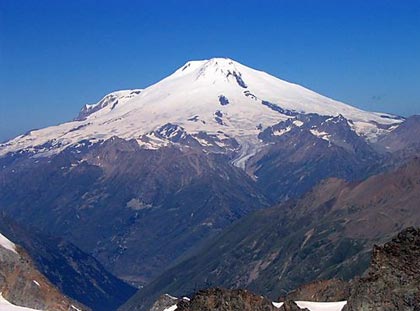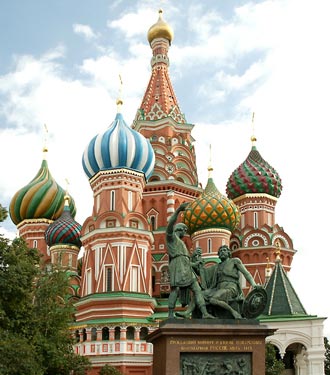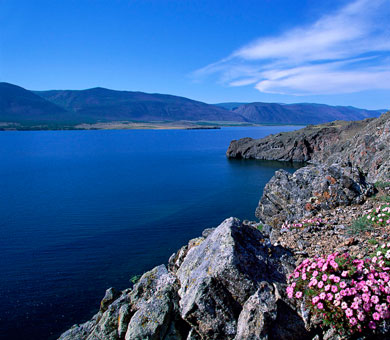Russia
Country statistics

Land area: 6,562,078 sq miles (16,995,800 sq km)
Total area: 6,592,772 sq miles (17,075,200 sq km)
Population (2011 est.): 138,082,178 (growth rate: -0.48%); birth rate: 10.94/1000; infant mortality rate: 9.88/1000; life expectancy: 66.46; density per sq miles: 21.5
Capital City: Moscow
Monetary unit: Ruble
Languages: Russian, others
Ethnicity/race: Russian 81.5%, Tatar 3.8%, Ukrainian 3%, Chuvash 1.2%, Bashkir 0.9%, Byelorussian 0.8%, Moldavian 0.7%, other 8.1% (1989)
Religions: Russian Orthodox, Islam, others
Country introduction

Russia is the largest country in the world with a total area of 17,075,400 sq meters (over 6.5 million sq miles) consisting of a very diverse geography. It spans two continents (Europe and Asia) and borders Poland, Ukraine, Belarus and the Baltic States to the west, Finland to the north, Georgia, Kazakhstan, Azerbaijan, Mongolia and China to the south, and North Korea to the east. The United States and Japan are not far from the eastern coast of Russia.
Nearly 70% of Russia is covered by vast plains and steppes. The Eastern European (Russian) Plain, replete with low plateaus is found in Western Russia and include the low Valdai, Central Russian, and Volga Hills as well as the Oka-Don and Caspian Lowlands. The Central Siberian plateau, consisting of undulating countryside, combined with high mountains and a complex chain of deep river valleys the Yenisei and the Lena, gradually transforms into the Central Yakut plain.
Mountain ranges are mostly located in Russia's eastern regions and in some of its southern areas. The Ural mountains cover 4,023 km (2,500 miles) of Eastern Russia and constitutes a natural boundary separating European and Asian Russia. Various mountain ranges making up the northern slope of the Greater Caucasian mountain range are located in Southern Russia. Situated within the western part of the Caucasus mountain range, Mount Elbrus is considered the highest mountain, not only in Russia, but also in the whole of Europe with the highest point being 5,642 m (18,510 ft). Another mountain chain, including the Altai range, is found in Southern Siberia. The Kamchatka mountains (including some active volcanoes) stretch along the Pacific coast.
Russia has about 120,000 rivers over 10 km (6 miles) long. The total length of these rivers is 2.3 million km (888,034 miles). The largest rivers are the Ob, Irtysh, Yenisey, Amur, and Volga in the European part of the country. There are about 2 million freshwater and salt lakes in Russia. The largest lakes are Lake Baikal (which holds about 20% of the world's total freshwater supply, not counting the fresh water frozen in the polar ice caps and glaciers), Lake Ladoga, Lake Onega, and Lake Taimyr.
Three quarters of the Russian population lives in the cities and towns of Western Russia. About 25% of the population still live in rural areas.
The culture

Russia has undergone many upheavals in the course of the century. It has moved from being a huge empire ruled by a centuries-old monarchy to a Communist superpower which shaped world politics for decades until the Union collapsed and Russia became a post-industrial, post-modern nation, much weakened and struggling to achieve a semblance of its former glory.
Despite its complicated history full of devastating wars and battles, Russian people speak with pride about their country, and are often eager to share their traditions, their passion for life and their rich culture.
Though those who live in Russia are called "Russians", about 160 various ethnic groups can be found in the country. Russian is the official language, though over 100 languages are spoken by its peoples. The majority of Russians identify with the Eastern Orthodox (Christian) religion, but Judaism, Islam, and Buddhism are also practiced in Russia.
Russian celebrates standard Western holidays, such as Christmas, New Year's and Easter, but other holidays, like Victory Day and International Women's Day take on special emphasis in Russia. Russian holidays also recognize uniquely Russian achievements, for example, Cosmonaut Day celebrates Russia's achievements in space exploration. Other religious and folk holidays include Maslenitsa, also known as Butter Week, Pancake week, or Cheesefare Week which is celebrated during the last week before the Great Lent, and Ivan Kupala Day which has been celebrated since ancient times at the end of June that consists of ritual acts, songs, chants and all kinds of fortune-telling.
Russian handcrafted souvenirs make wonderful gifts and home decorations. The most well-known Russian craft is the matryoshka doll, or painted nesting doll. Finely decorated lacquer boxes also make special souvenirs. Regional and national styles (think Khokhloma and Palekh) of folk craft, as well as materials (birchbark) typify handicrafts. These can be purchased at souvenir markets. Some are of heirloom quality and bring enjoyment to multiple generations. Russian Art has been gaining popularity in the West. There's evidence of ever growing international interest in the rich and varied talents of Russian and Soviet artists.
Russia has more than 50,000 state public libraries and a thousand or more art galleries. The Russian literature has undergone significant changes at different periods, each era having distinct characteristics of its own. Popular Russian writers include, Dostoevsky, Tolstoy, Chekhov, Joseph Brodsky and Sergei Dovlatov.
Attractions & landmarks

Among the numerous tourist destinations in Russia, the capital Moscow is the most visited by travelers. Here visitors will be presented by the majestic St Basil's Cathedral, which was constructed from 1555 to 1561 by order of Ivan IV ("Ivan the Terrible") to celebrate the defeat of Kazan, the last remaining grip of the Mongol Empire on European lands. Other attractions include the Pushkin Museum of Fine Arts, the reputed Novodevichy Monastery, the Tretyakov Gallery and the Moscow Kremlin, a historic fortified complex that overlooks the Moskva River, Saint Basil's Cathedral and the Red Square. The Red Square is important in the history of Russia and stands in between the Kremlin and the royal house where the President of Russia stays.
Natural landmarks of Russia include the Altai Mountains, which offers a unique scenic, cultural and historical attraction, with rushing streams, alpine meadows, rocky mountains and caves. The mighty mountains are located in the southern portion of Siberia and stand close to Mongolia, Kazakhstan and China.
Another major destination is Lake Baikal, located in the south of the Russian region of Siberia. It is considered the most voluminous freshwater lake in the world, containing roughly 20% of the world's unfrozen surface fresh water. The lake is also the world's clearest and oldest, at 25 million years and deepest, averaging at 744.4 m (2,442 ft).
South Ural tops the list of tourist destinations in Russia and attracts amazingly beautiful nature, numerous rivers, healing springs, birch-woods, floodplain lakes and storage ponds. There is also the famous steppes region that consist of grassland plains, and some of the famous national parks.
The Ferapontov Monastery is considered one of the purest examples of Russian medieval art and is a place worth visiting. Also, the volcanoes of Kamchatka is a fascinating sight that will allow visitors to see the lava deposits forming varied ecosystems. Hot springs rich in mineral deposits, mud cauldrons and geysers can also be found here.